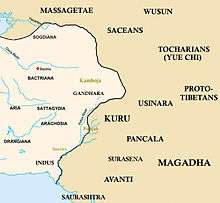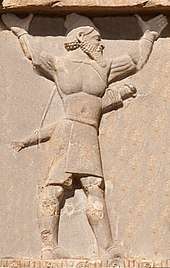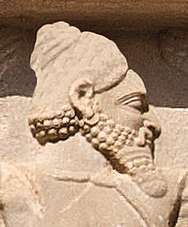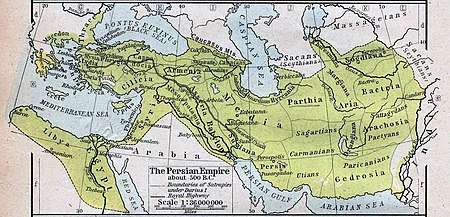Hindush
Hindush (or Hindūš) was an Indian province of the Achaemenid Empire following the Achaemenid conquest of the Indus Valley circa 500 BC. According to Herodotus, it was the "easternmost province" of the empire. It is believed to have continued as a province until the invasion of the empire by Alexander the Great circa 326 BC.


H-n-d-wꜣ-y
Hindush/India[1]
Name
Hindush was written in Achaemenid inscriptions as Hidūsh (Old Persian cuneiform: 𐏃𐎡𐎯𐎢𐏁, H-i-du-u-š). It is also transliterated as Hindūš since the nasal "n" before consonants was omitted in the Old Persian script, and simplified as Hindush).[2][3]
It is widely accepted that the name Hindush derives from Sindhu, the Sanskrit name of the Indus river as well as the region at the lower Indus basin (modern Sindh). The Proto-Iranian sound change *s > h occurred between 850–600 BCE, according to Asko Parpola.[4] The -sh suffix is common among the names of many Achaemenid provinces, such as Harauvatish (the land of Harauvati or Haraxvaiti, i.e., Arachosia) or Bakhtrish (Bactria). Accordingly, Hindush would mean the land of Sindhu.
The Greeks of Asia Minor, who were also part of the Achaemenid empire, called the province 'India'. More precisely, they called the people of the province as 'Indians' ('Ινδοι, Indoi[5]) The loss of the aspirate /h/ was probably due to the dialects of Greek spoken in Asia Minor.[6][7] Herodotus also generalised the term "Indian" from the people of Hindush to all the people living to the east of Persia, even though he had no knowledge of the geography of the land.[8]
Location

The territory may have corresponded to the area covering the lower and central Indus basin (present day Sindh and the southern Punjab regions of Pakistan).[9] To the north of Hindush was Gandāra (spelt as Gandāra by the Achaememids). These areas remained under Persian control until the invasion by Alexander.[10]
Alternatively, some authors consider that Hindush may have been located in the Punjab area.[11]
Hindush in the Achaemenid army
According to Herodotus, the 'Indians' participated to the Second Persian invasion of Greece circa 480 BCE.[14] At the final Battle of Platea (479 BCE), they formed one of the main corps of Achaemenid troops (one of "the greatest of the nations").[15][16] Indians were still supplying troops and elephants for the Achaemenid army at the Battle of Gaugamela (331 BCE).[17] They are also depicted on the Achaemenid tombs of Naqsh-e Rostam and Persepolis.
See also
- Achaemenid invasion of the Indus Valley
- India (Herodotus)
References
- "Arachosia, Sattagydia, and India are represented and named among the subject nations sculptured on the base of the Egyptian statue of Darius I from Susa."Yar-Shater, Ehsan (1982). Encyclopaedia Iranica. Routledge & Kegan Paul. p. 10. ISBN 9780933273955.
- Some sounds are omitted in the writing of Old Persian, and are shown with a raised letter.Old Persian p.164Old Persian p.13. In particular Old Persian nasals such as "n" were omitted in writing before consonants Old Persian p.17Old Persian p.25
- DNa - Livius.
- Parpola, The Roots of Hinduism (2015), Chapter 9.
- 'Ινδοι, Greek Word Study Tool, Tufts University
- Horrocks, Geoffrey (2009), Greek: A History of the Language and its Speakers (Second ed.), John Wiley & Sons, pp. 27–28, ISBN 978-1-4443-1892-0: "Note finally that the letter H/η was originally used to mark word-initial aspiration... Since such aspiration was lost very early in the eastern Ionic-speaking area, the letter was recycled, being used first to denote the new, very open, long e-vowel [æ:] ... and then to represent the inherited long e-vowel [ε:] too, once these two sounds had merged. The use of H to represent open long e-vowels spread quite early to the central Ionic-speaking area and also to the Doric-speaking islands of the southern Aegean, where it doubled up both as the marker of aspiration and as a symbol for open long e-vowels."
- Panayotou, A. (2007), "Ionic and Attic", in A.-F. Christidis (ed.), A History of Ancient Greek: From the Beginnings to Late Antiquity, Cambridge University Press, p. 410, ISBN 978-0-521-83307-3: "The early loss of aspiration is mainly a characteristic of Asia Minor (and also of the Aeolic and Doric of Asia Minor)...In Attica, however (and in some cases in Euboea, its colonies, and in the Ionic-speaking islands of the Aegean), the aspiration survived until later... During the second half of the fifth century BC, however, orthographic variation perhaps indicates that 'a change in the phonetic quality of [h] was taking place' too."
- Arora, Udai Prakash (2005), "Ideas of India in Ancient Greek Literature", in Irfan Habib (ed.), India — Studies in the History of an Idea, Munshiram Manoharlal Publishers, p. 47, ISBN 978-81-215-1152-0: "The term 'Indians' was used by Herodotus as a collective name for all the peoples living east of Persia. This was also a significant development over Hekataios, who had used this term in a strict sense for the groups dwelling in Sindh only."
- M. A. Dandamaev. "A Political History of the Achaemenid Empire" p 147. BRILL, 1989 ISBN 978-9004091726
- Rafi U. Samad, The Grandeur of Gandhara: The Ancient Civilization of the Swat, Peshawar, Kabul and Indus Valleys. Algora Publishing, 2011, p. 33 ISBN 0875868592
- "Hidus could be the areas of Sindh, or Taxila and West Punjab." in Cambridge Ancient History. Cambridge University Press. 2002. p. 204. ISBN 9780521228046.
- Naqs-e Rostam – Encyclopaedia Iranica.
- Naqs-e Rostam – Encyclopaedia Iranica List of nationalities of the Achaemenid military with corresponding drawings.
- Herodotus VII 64-66
- "A Sindhu contingent formed a part of his army which invaded Greece and stormed the defile at Thermopylae in 480 BC, thus becoming the first ever force from India to fight on the continent of Europe. It, apparently, distinguished itself in battle because it was followed by another contingent which formed a part of the Persian army under Mardonius which lost the battle of Platea"Sandhu, Gurcharn Singh (2000). A military history of ancient India. Vision Books. p. 179.
- LacusCurtius • Herodotus — Book IX: Chapters 1‑89. pp. IX-32.
- Tola, Fernando (1986). "India and Greece before Alexander". Annals of the Bhandarkar Oriental Research Institute. Annals of the Bhandarkar Oriental Research Institute Vol. 67, No. 1/4. 67 (1/4): 165. JSTOR 41693244.CS1 maint: location (link)


